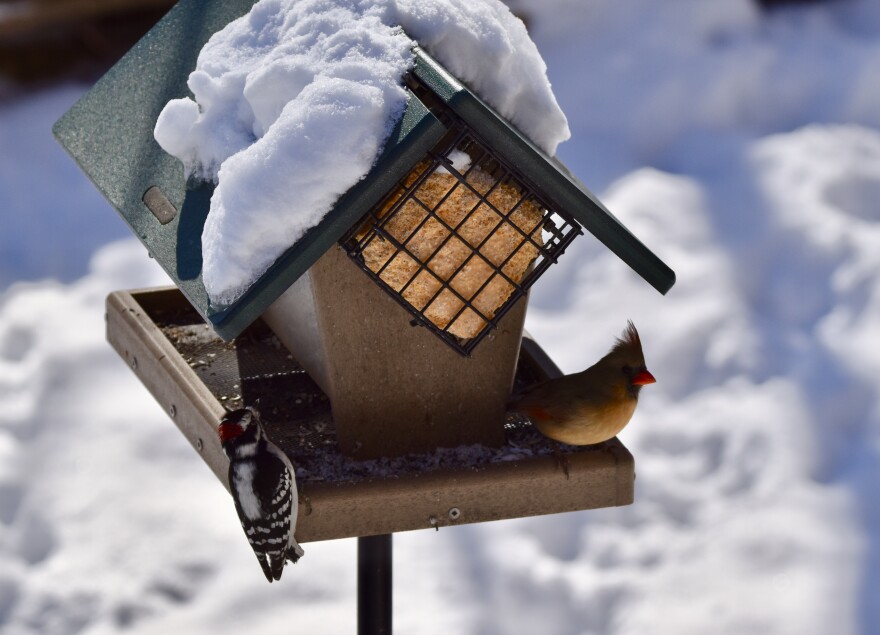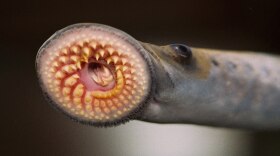Editor's Note: This story originally aired on Nov. 22, 2024.
Most people can easily survive the winter weather by layering up and turning on the heater.
But it’s more complicated for birds.
For this month’s Chirp Chat, Lake Effect’s Xcaret Nuñez spoke with Toby Seegert, the regional conservation specialist for the Zoological Society of Milwaukee.
He says winter is a great time to keep backyard bird feeders stocked to help birds stay nourished through the season. He also explains how the Milwaukee County Zoo cares for wild birds year-round.
How do birds cope with the winter weather?
- Fluffing up: Birds fluff up their feathers in cold weather to trap as much body heat as possible and stay warm.
- Hunkering down: Birds seek shelter in dense trees or shrubs. Old tree cavities and nest boxes also serve as year-round roosting spaces. Birds will huddle together during the winter to share body heat and stay warm.
- Adding ounces: Birds build up warmth and energy by eating more during the winter. For some small birds, like chickadees and finches, fat can account for more than 10% of their winter body weight. For birds that skip migration, the energy they save and build up becomes crucial when food is scarce.

How you can help birds survive the winter
Seegert says he keeps bird feeders out year-round, but winter is when birds rely on them the most. He says the cold weather limits natural food resources, like insects and seeds, so supplying birds with seeds and suet helps give them energy through the winter.
Seegert also notes that keeping bird feeders out during the winter will not prevent birds from migrating — a common myth.
“If a bird wants to migrate, it’ll migrate — its body will tell it that it’s time to move on,” Seegert says. “So if they do choose to be there longer, or if they decided that they don't want to migrate, they'll still have those resources and that energy to keep going through the winter.”
Seegert says suet, black oil sunflower seed, and nyjer seed all tend to have higher fat content. He recommends people feed them to birds during the winter. He also says it’s important to have water sources, like bird baths, available.
“If you're putting [bird feeders or baths] near any kind of building with a window, we tend to recommend that people have them either less than three feet away or greater than 10 feet away from the window,” Seegert says. “That's so when birds are flying, if it's less than three feet [from the window], they're not able to get enough momentum to hit and injure themselves. And if it's greater than 10 feet, they're less likely to smack into the window.”

Wild Birds Program
The Zoological Society of Milwaukee partners with the Milwaukee County Zoo to conserve wild bird species across southeast Wisconsin through the Wild Birds Programs. They work to reach this goal through various conservation activities that include monitoring birds, providing resources to birds and educating visitors through outreach programs.
- Weekly Point Count Surveys: Every week, Seegert says he visits 11 locations throughout the zoo to check for biodiversity. With the help of volunteers, Seegert says he records every bird they hear and see at each location and uploads the data to the Cornell Lab of Ornithology’s eBird database.
- Nest Box Monitoring: There are 36 nest boxes located throughout the zoo to support smaller birds, like black-capped chickadees, tree swallows and house wrens. Seegert says the nest boxes are monitored from April through August and the data they collect gets uploaded to the Cornell Lab of Ornithology’s Nestwatch database.
- Project Feederwatch: There are over 30 bird feeders located throughout the zoo and maintained year-round. Project Feederwatch is a community science program through the Cornell Lab of Ornithology that focuses on monitoring bird feeder activity during the winter. Seegert says he monitors and records the birds that visit the feeders with the help of volunteers and uploads the data to Cornell’s database.
- Backyard Bird Walk Exhibit: The zoo’s Backyard Bird Walk exhibit opened in August 2023, to help visitors learn the various ways they can help support migratory birds and native pollinators and help prevent bird strikes – all at home.
Chirp Chat’s Bird of the Month for November

Despite the name, their pale red bellies can be difficult to see. The striking black-and-white striped backs and bright red caps often lead them to be mistaken for Red-headed woodpeckers. Male red-bellied woodpeckers can be identified by their red crown and red nape, while female red-bellied woodpeckers only have a red nape.
“[Red-bellied woodpeckers] are just very charismatic and a lot of fun,” Seegert says. “I find they make some interesting calls too — almost every woodpecker species sounds like it’s laughing… at least, the longer version of their calls.
“It kind of just sounds like they're having a chuckle. The downy, hairy, red-bellied, northern flicker — they all have a little bit of a different laugh, just like people. So I think that that's a lot of fun to watch out for, too.”







